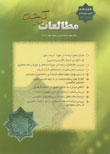Functions of Translation in Nations’ Literature: The Case of Persian and Arabic Literature
Abstract
Translation is one of the primary ways to cross the borders of one literature and enter “another's” territory and it is a means to prevent the literature of a nation from retreating and consequently declining. The present study therefore attempts to show the role of translation in creating and directing the relations between literatures of different nations. It also tries to illustrate that translation has an outstanding position in comparative literature. To achieve this goal, first some functions of translation in literature (the effect of the text selected for translation on the target language literature, understanding the history of nations through the study of translated works, the effect of translation on the history of nations, and arousing the interest of target language recipients towards the literature of source language) are presented. Then, to show the mutual effect of Persian and Arabic literatures, the most prominent functions of translations from Pahlavi into Arabic are reviewed; these functions include: establishment of historiography in Arabic culture and literature, creation of fables with political themes, use of dialogue and debate in the structure of literary texts, expansion of narrative literature, etc.Published
2011-05-31
How to Cite
Mohammadi, E., & Emami, H. (2011). Functions of Translation in Nations’ Literature: The Case of Persian and Arabic Literature. Iranian Journal of Translation Studies, 9(33). Retrieved from https://journal.translationstudies.ir/ts/article/view/462
Issue
Section
Academic Research Paper
License
Copyright Licensee: Iranian Journal of Translation Studies. This article is an open access article distributed under the terms and conditions of the Creative Commons Attribution–NonCommercial 4.0 International (CC BY-NC 4.0 license).





